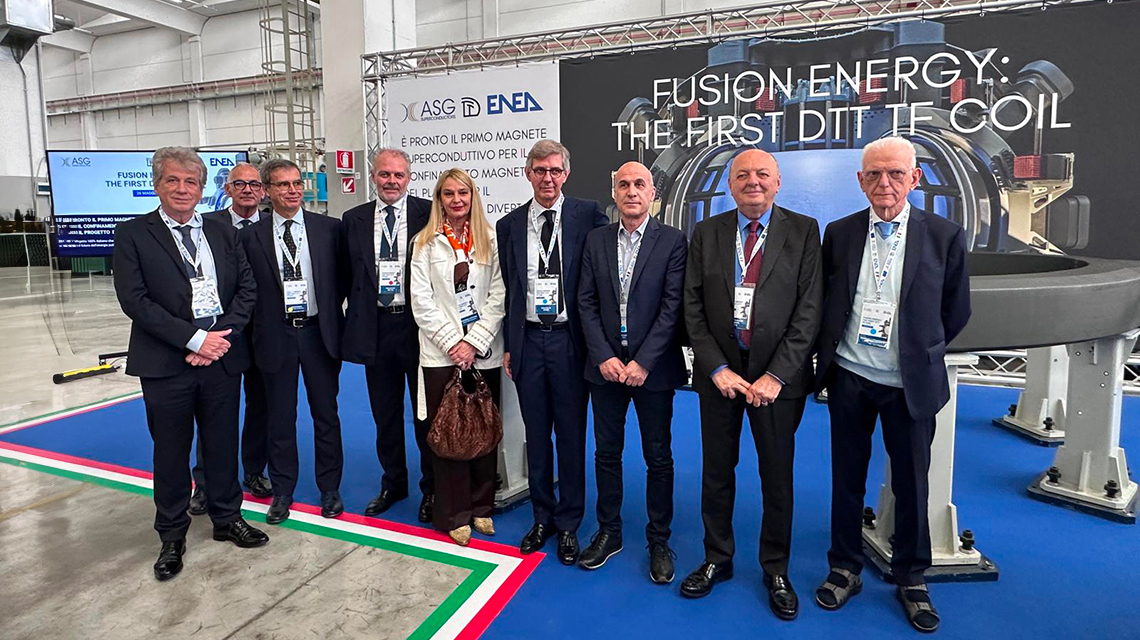Italian National Agency for New Technologies, Energy and Sustainable Economic Development

Nuclear: Fusion energy, the first magnet for the Italian DTT project ready
The inauguration at the ASG Superconductors factory in La Spezia in the presence of the Minister for the Environment and Energy Security Gilberto Pichetto Fratin
Italian research and industry together to produce clean, safe and unlimited energy with nuclear fusion. The first magnet for the DTT - Divertor Tokamak Test project, the 100% Italian experimental machine under construction at the ENEA Research Centre in Frascati (Rome), was presented at the ASG Superconductors plant in La Spezia, in the presence of the Minister for the Environment and Energy Security Gilberto Pichetto Fratin.
At over 6 metres in height and weighing 16 tonnes each, the superconducting magnet represents the true technological ‘heart’ of the DTT project: inside, cutting-edge construction technologies and innovative materials will ensure the containment of 33 cubic metres of plasma at a temperature of over 100 million degrees.
DTT represents a frontier initiative, all-Italian, aimed at producing clean, safe and large-scale energy through the same physical principle that powers the Sun and the stars: nuclear fusion. The project is configured as a link between the large international programmes ITER and DEMO, the latter of which is intended, after 2050, to feed electricity from fusion into the grid. The realisation
The realisation of DTT is awaited with great interest by the scientific and technological community, as it will be able to provide crucial answers to some of the main challenges still open on the path to fusion energy production, such as managing the extremely high power flows generated by plasma.
The magnet presented today is the first of 18 magnets to be produced by ASG Superconductors - a company owned by the Malacalza family - specialising in superconducting technology for energy and medical applications, with headquarters and facilities in Liguria.
Giorgio Graditi, ENEA Director General, highlighted: ‘We are particularly proud to contribute, with our skills and infrastructures, to this result, which represents an important step forward in the roadmap for the realisation of the DTT facility and for fusion energy in general; in the panorama of scientific and technological research in the nuclear fusion sector, ENEA plays a role of primary importance and contributes significantly, in its centres of excellence in Frascati and Brasimone (Bologna), to the development of innovative and frontier technologies, and to studies on the safety of the plants and their environmental impact. Today we can make advanced computing infrastructures available, as well as design components of high technological complexity, such as cables and superconducting magnets,' added Graditi. 'These activities are carried out as part of Eurofusion, the European Fusion Consortium, which brings together the EU countries plus Switzerland and Ukraine; we act as the national programme manager here, coordinating the activities of 22 partners including Italian universities, industries and research bodies,' he concluded.
Francesco Romanelli, DTT president, said: ‘The realisation of the first toroidal magnet of the DTT project marks a milestone not only for our experimental machine but for the entire fusion industry in Italy. It is a concrete demonstration that public research and private industry, when working in synergy, can successfully tackle scientific and technological challenges of global significance. The magnet we are presenting today is the fruit of extraordinary work: a concentrate of innovation, precision engineering and know-how that places our country among the leading players in nuclear fusion as a source of clean and sustainable energy. DTT was created to accelerate the energy transition, to train new generations of researchers and technologists, and to make a decisive contribution to the construction of the reactors of the future, capable of producing energy that is not only clean but actually inexhaustible. Today, this further concrete result allows us to look ahead with even more confidence and determination'.
Marco Nassi, CEO of ASG Superconductors, said: ‘Today we are celebrating the production of the first superconducting magnet for ENEA's Italian DTT fusion project, an important technological and industrial milestone. ASG has realised the magnetic core of the most important international nuclear fusion projects such as ITER, JT60SA, JET and W7-X, and is successfully and proactively collaborating with ENEA on fusion issues, with a view to future Italian projects such as DTT and European and international ones. Furthermore, ASG, thanks to its experience and know-how on superconductive materials, is developing innovative applications, cables and systems for the transport and storage of electrical energy and for the protection and stabilisation of electricity grids, in order to provide concrete solutions to the increasing demand for energy and the new requirements of the green deal'.
The DTT project is promoted by a consortium involving ENEA, Eni and numerous Italian universities and research institutions. The initiative envisages a total investment of over EUR 600 million and is estimated to generate an economic and employment impact of around EUR 2 billion. The project will also create one of the most advanced scientific-technological centres in the world, conceived as an international hub open to researchers and scientists from all over the world.
What is nuclear fusion?
Nuclear fusion is a process that aims to produce renewable, inexhaustible electricity in an intrinsically safe way, using the same mechanism that ‘lights up’ the stars. Energy arises from the union of two nuclei of very light elements such as, for example, hydrogen; the reaction gives rise to a neutron and helium, a noble gas widely used in everyday life. No greenhouse gases or radioactive waste are produced, and no accidents involving the population are possible: in fact, the only radioactive materials (the tritium part of the fuel and the activation products generated during operation) are inside the reaction chamber, which has no contact with the outside world. In addition to environmental friendliness and intrinsic safety, fusion makes it possible to develop innovative technologies that can be applied in numerous fields. There are two ways of inducing fusion: one based on magnetic confinement, in which large magnets made of superconducting materials harness hydrogen gas by confining it inside a doughnut where it is heated to temperatures of over 100 million degrees in a particular state called ‘plasma’.
